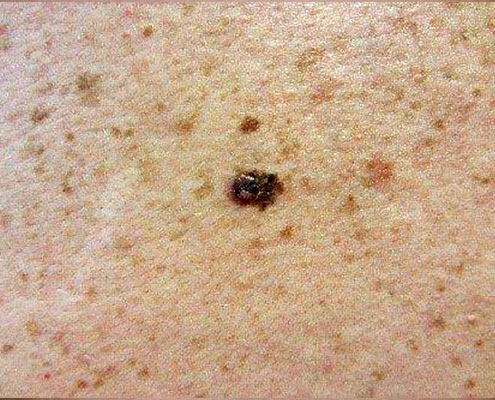Melanoma Removal and Treatment
Melanoma is the most serious and potentially deadly form of skin cancer. It results from the uncontrolled growth of the pigment cells of the skin (melanocytes). Melanomas are most common on sun exposed skin surfaces, but can occur on the palms, soles of the feet, under finger and toenails, on the genitals, around the anus, in the mouth and even in the eye. It is more common in older people, but it can occur at any age, even in children. Melanomas are often caused by sun damage and the use of tanning beds but are also caused by many other factors including a genetic or family history of melanoma. They are also more common in people who have many moles.
Early detection and treatment is critical to the wellbeing of people with melanoma. Any new or changing or unusual mole should be examined by a dermatologist as soon as possible. Melanomas usually are brown or dark brown or black in color. They may be flat or raised. They are not usually painful. They may also appear as a brown mark under a finger or toenail. They may also be pink or red in color and may bleed or not heal.
If diagnosed and treated early, most melanomas are treatable. However, if left untreated melanomas can spread (metastasize) to other areas of the body and become an extremely serious medical problem that can be deadly. If a melanoma is suspected by your doctor, a biopsy is done by taking a piece of the tumor and examining it under a microscope. Treatment usually involves surgical removal of the skin tumor. Sometimes lymph nodes will also be taken to examine for signs of spread of the tumor. If the tumor has spread to other areas of the body, internal medications and radiation may be used to treat the cancer.
At our dermatology centers in Arcadia/Phoenix, Surprise, and Peoria, we specialize in advanced melanoma removal and treatment options. Our experienced dermatologists are dedicated to providing comprehensive care for individuals dealing with melanoma. From early detection to advanced treatment, our team is committed to ensuring the best possible outcomes for our patients. We understand the critical importance of timely intervention, and our state-of-the-art facilities are equipped to offer a range of treatments tailored to each patient’s unique needs.
Frequently Asked Questions For Melanoma Treatment
- How is melanoma removal performed? Our skilled dermatologists employ various techniques for melanoma removal, including surgical excision, Mohs surgery, and laser therapy, ensuring thorough and effective removal while prioritizing optimal cosmetic results.
- What treatment options are available for melanoma? Our dermatology centers offer a comprehensive array of melanoma treatment options, ranging from surgical interventions to advanced targeted therapies and immunotherapies, all personalized to address each patient’s specific condition.
- Is early detection important for successful melanoma treatment? Absolutely. Early detection plays a crucial role in successful melanoma treatment outcomes. Our team emphasizes regular skin checks and prompt evaluation of any suspicious moles or skin changes to ensure timely intervention.
- Can melanoma spread if left untreated? Yes, untreated melanoma can spread to other areas of the body and become life-threatening. Swift diagnosis and treatment are essential to prevent the progression of the disease and its potential complications.
- What role does a dermatologist play in melanoma care? Dermatologists are instrumental in melanoma care, from accurate diagnosis and staging to recommending the most appropriate treatment plan. Our experienced professionals are dedicated to guiding patients through their journey, ensuring the best possible care and outcomes.



